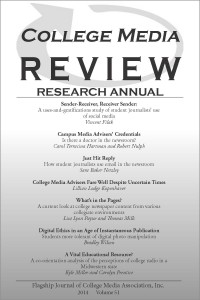College media research the focus of Vol. 51
By Bob Bergland
Missouri Western State University

Welcome to the second College Media Review Research Annual. Although College Media Review remains in an online format, we once again are compiling all of the year’s research into an annual publication, in PDF form and also available in hard copy as a print-on-demand book.
The continued presence of the Research Annual is critical in three main ways. First and foremost, it serves as a vehicle for disseminating key research about the field. This research answers many questions both new and experienced advisers have about how college media operates outside of their campuses. Those who follow the CMA listserv know that it is peppered with questions from advisers about issues such as editor pay, content, advertising and ethics. As with last year’s edition, this Research Annual is able to answer some of those questions, providing hard data for editors, advisers and deans, going beyond just anecdotal examples. Second, this journal also provides a publication outlet for CMA members. While a few other journals have published some studies about college media, there is no friendlier home for such research than College Media Review, and no place that encourages such diverse methodologies. Having this Annual be available in print form also helps scholars who are at institutions stuck in the 20th Century who are not as accepting of online journals for promotion and tenure consideration, even if those articles are peer-reviewed. Finally, the continued existence of College Media Review and \ the Research Annual and CMA in general (the Nordin Award for research, the CMA conventions and the CMA slot at the AEJMC convention) help promote future research—sort of a “if you build it, they will come” approach, except, of course, that College Media Review has been around for more than half a century. Hopefully that future research will answer more questions posed on the listserv and elsewhere.
In the meantime, this volume provides much useful information on a variety of topics. Vince Filak explores a very timely topic: student use of social media, through the lens of uses and gratifications theory. In a similar vein, Sara Baker Netzley studies student use of email, specifically for interviewing/newsgathering purposes. Lisa Lyon Payne and Thomas Mills provide an important snapshot of the content of hard copy college newspapers, looking at what topics are covered on their front pages. Using a qualitative research methodology, Kyle Miller and Carolyn Prentice examine college radio stations, a much understudied part of college media, employing co-orientation theory and administrator/adviser/student perceptions of the radio station. Bradley Wilson looks at advisers, students and professionals in his study about photojournalism ethics. Carol Terracina Hartman and Robert Nulph turn their focus solely on college media advisers, providing nationwide data for a key question in the field: should a Ph.D. be required for the skills-centered adviser position? Last, but definitely, definitely not least, Lillian Lodge Kopenhaver also provides research on advisers, giving a very useful broadbased overview on issues such as compensation, load and departmental placement, comparing the results of her 2014 study with a similar seminal study done three decades earlier. Both Kopenhaver and Wilson have companion articles that will be published in the next Research Annual volume.
I hope these seven articles not only provide useful information, but also serve to spark more ideas for research. There are many, many areas of college media that are fertile ground for future exploration. I encourage all of the readers to look through these first two Research Annuals, through past CMR archives, and through the CMA listserv in looking for what has been done and what could and should be studied in the future.

As I leave the journal and hand over the reins to the very capable CMR team of Debbie Landis (executive editor), Bradley Wilson and Carol Terracina Hartman (managing editors) and Bill Neville (webmaster), I would like to thank all of the authors for their contributions to the journal and the field. I’d especially like to acknowledge the work of Lillian Lodge Kopenhaver, the associate editor in charge of research, for her work in coordinating the peer reviews of the articles. Finally, I’d like to thank Katelyn Canon, assistant editor for this Research Annual, for all of her hard work.
